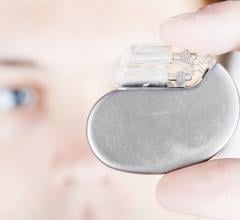
April 30, 2014 — Scripps Health became the first health care provider in Southern California to implant the investigational Nanostim leadless pacemaker, the world's first wireless pacemaker totally implanted in the heart, as part of the Leadless II Clinical Trial. Developed for patients with bradycardia — a heart rate that is too slow — the Nanostim is placed directly in a patient's heart without the visible lump, scar and insulated wires (leads) required for conventional pacemakers.
Nina Korabelnikov, 83, from Encinitas, Calif., was implanted with the device on April 22 at Scripps Memorial Hospital La Jolla because she had an erratic heart rate — sometimes her heart would beat very slowly and other times it would race uncontrollably.
"With the Nanostim pacemaker, we are hoping to control Korabelnikov's slow heart rates, so we can more safely increase her medication to treat her fast heart rates," said Steven Higgins, M.D., director of cardiac electrophysiology, Scripps Memorial Hospital La Jolla, who performed the implant procedure.
Higgins was able to install the Nanostim leadless pacemaker — a device approximately one-tenth the size of a traditional pacemaker — by inserting a catheter into a vein in the patient's groin area. He then steered it through the vessel into the patient's heart and screwed it into the inside of the heart's right ventricle before removing the catheter. The entire procedure took less than one hour.
Cardiac pacemakers monitor the heart and provide electrical stimulation when the heart beats too slowly for each patient's specific physiological requirements. More than 4 million people worldwide have an implanted pacemaker or other cardiac rhythm management device, and an additional 700,000 patients receive the devices each year.
Traditional pacemakers include two components: a battery-powered generator that produces the electrical stimulation, and wires that deliver the stimulation to the head when needed.
"An Achilles' heel of traditional pacemakers is that they have leads or wires that go from the battery to the heart, and sometimes these can break due to excessive strain. Removing and replacing these results in additional hospital visits and can result in complications," said Higgins. "With the Nanostim, there are no wires involved, so we are hoping that this device will last longer with fewer complications."
The implant took place as part of the Leadless II pivotal trial, a prospective, non-randomized, multicenter, international clinical study designed to evaluate the safety and effectiveness of the Nanostim leadless pacemaker in patients indicated for the device in the United States. The study is expected to enroll approximately 670 patients at 50 centers. Higgins and Scripps Clinic cardiologist John Rogers, M.D., are co-investigators at Scripps, the only San Diego location to participate in the trial.
The trial will determine if the U.S. Food and Drug Administration (FDA) approves the device's use in the United States. It is currently available in select European markets.
"The hope is that this new procedure will allow patients to regulate their heart rates without dealing with the chest pocket and other complications that may arise from having a traditional pacemaker," said Rogers. "In addition, patients are routinely placed on activity restrictions with conventional pacemakers in an attempt to prevent dislodgement or damage to a lead. With this new device, patients do not have those restrictions and can potentially continue living active, uninhibited lifestyles."
For more information: www.scripps.org


 May 02, 2025
May 02, 2025 









